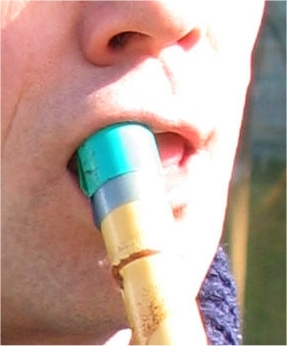Four months ago I made a G flute from a flagstick.
This calculator takes care of drilling details: http://11wall-west.com/~ph_kosel/flutomat.html. These are the measurements I used:
The holes I made are ugly.. punctured with a sewing needle then “dug” out with pencil and scissors. There is no mouthpiece. The end is just flat like a straw. It is almost the same way ancient people put six holes into a segment of reed from a riverbank.
The way woodwind works is the stream of air must split in half. The recorder is easiest to play since the design splits the air for you. The modern flute is a little harder since you must aim at the edge (or maybe not, I never played one). As for my straw-like flute, it is quite something else..
The sounding concept of my flat brim flute is pretty much like a ney, which I learned from here: http://www.neyzen.com/ney_metodu.html. The technique is veeeeery hard. You are somehow supposed to split your airstream on the flat brim. A subtle twitch in lip shape, ney angle, or tongue placement is enough to extinguish the sound. As you can see I only managed three notes (D, E, F#) after trying for three months:
By the way, there is another sounding technique which requires wedging the edge between your two front teeth and hissing like a viper.. This Persian method creates a unique tone, but no thanks. The Arabic/Turkish method I am using is difficult enough.
Really, during the first three months I only produced air and wispy harmonics. As you may or may not have known from A Cringeworthy Process, I a not one to give up so quickly. This is recently, my fourth month trying:
I achieved two extra notes by overblowing the D and E to get their perfect fifths A and B. The fingerings are the same, but the stronger breath makes the second harmonic (perfect fifth) ring. For some insight to how it works, refer to Harmonic Intervals and Resonance and Timbre and Overtones. I can manage overblown octaves as well, but my breath transition needs some attention first. It is generally not recommended that I learn so many notes before mastering the sound quality.. still working on it!
How was the first flute inspired? My guess is an observation of wind flowing through an empty log. But from this flutemaking experience I find that flat brimmed flutes are really hard to play. Even after making the flute, it takes three months' effort to produce a sound (perhaps even longer for the first flutist ever, since there are no preceding flutists to teach the first). Either ancient people had nothing better to do, or they were increeeeedibly smart. I think they actually were smart.
Five notes (D, E, F#, A, B) is enough to play a couple songs but let me work my intonation first. Then I might play you something decent..



well ...it's 2019 but who's counting. thanks for your input/output. i have quite a few flutie looking instruments ...enjoy tyhe learning as much as the music. great fun can be had by all.
ReplyDelete